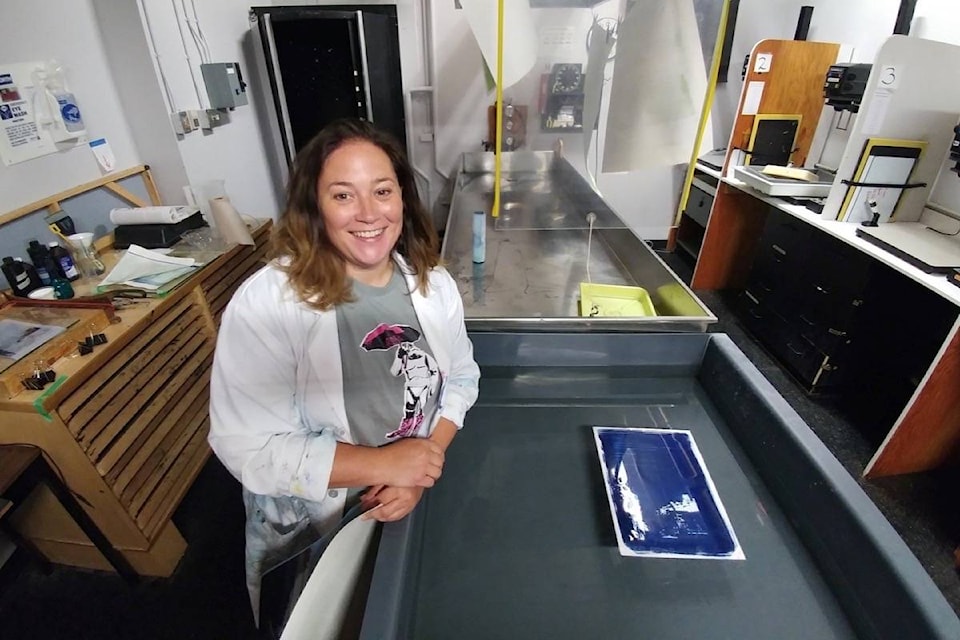Aileen Penner has a taxidermied rat and a new home at the Ranger Station Art Gallery.
The Victoria-based artist is starting a year as the artist in residence at the local gallery where she will work on a series of mixed media, collaged panels and sculptures that examine the role of humans in impacting, collecting and retelling the stories of nature.
What exactly does a rat have to do with any of that? Well, it’s still up in the air.
“Right now the rat is a professor and he’s going to be in a chem lab with jars full of of little people,” Penner said, adding that she can’t be sure exactly how the art will unfold.
That’s because during her year in Harrison, Penner is centering her work around a quote attributed to author Jon Mooallem that states, in part, “…We are everywhere in the wilderness with white gloves on, directing traffic.”
“My year kind of aims to look at that,” says Penner. “Is that true? If so, why is that happening and what are we going to do about that?
“The only thing I really know is that I’m going to play with the idea of the natural history museum – so the idea that these things that we call nature are behind glass in museums,” she added.
“I’m going to do a series of small, sculptural dioramas looking at people looking at nature…I really wanted to work on this specific project in nature, so this was a great opportunity for me. Hopefully I can create a body of work that reflects that.”
Trained formally as a writer and poet, Penner often mixes words with visual art. But she says that in general, being a writer influences her visual work.
“I’m always kind of observing and watching and listen closely to what I see. That really informs the visual art.”
As an artist, Penner defies convention, both in the conceptual and physical elements of her work.
She’s an “encaustic” painter, meaning she uses heated, pigmented beeswax to paint.
“I love it because it’s very textural…it’s very visual and surreal,” she explained.
Penner’s work has been exhibited at the Fortune Gallery, the North Vancouver Community Art Gallery, Gulf of Georgia Cannery in Steveston and the VIVO Media Arts Centre in Vancouver. Over the summer she was the artist in residence at Camosun College where she created a series of ‘cyanotypes’ for a solo show.
Cyanotypes, she explained, are created with an alternative photography process where a digital negative is printed out and placed onto clear film. After coating a piece of paper with light-sensitive chemicals, the negative is placed on top of the paper and exposed to sunlight for a pre-determined period of time.
“When you wash it out, what’s left is a beautiful, deep, deep blue and white image that’s basically a photograph but it’s also an original print,” she said.
Penner’s fearless use of atypical mediums mirrors her approach to facing some of society’s most difficult topics.
Her past work has focused on themes of death and loss. Having lost her own father at a young age, Penner understands the complexities of personal grief, but her art also explores larger “collective grief.”
“I’m sort of connected to that experience of loss personally, but I also really feel that we need to talk about it collectively. Not just human loss, but loss of species, loss of culture, loss of identities,” she said.
As an example, Penner mentions a pod of the southern resident orca population that has been in the news frequently as the whale’s face death and illness. The mother of a dead orca calf carried the body of her child on her back for weeks, breaking the hearts of people across the province.
Related: Orca’s tour of grief over after carrying dead calf around for nearly 3 weeks
But that grief is not new for people who have known about the pod and are fighting the climate change that’s destroying the habitats of species across the world.
“A lot of people who are close to that pod have been grieving their loss for years because we all know they’re dying,” Penner said. “I use a lot of concrete with my sculptures because it’s sort of representative of the heaviness around climate change…It almost feels like we can’t do anything about it but there’s the still the feeling that we’re not doing enough or we cant do enough.”
Penner will no doubt continue to create thought-provoking, norm-challenging work during her stay in Harrison.
Stay tuned for dates of a series of encaustic painting workshops Penner plans to host for those curious about the unique painting method.
